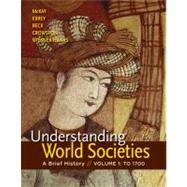Based on the highly successful A History of World Societies, Understanding World Societies: A Brief History combines innovative pedagogy with a manageable regional and comparative approach to capture students' interest in the everyday life of the past. Abridged by 25%, the narrative is paired with distinctive pedagogy, designed to help students focus on significant developments as they read and review. An innovative end-of-chapter study guide helps students master key facts and move towards synthesis.








